Indian Summer along the Rhine
Heidelberg and Strasbourg, September 10-15
As Valeriu sped south down the Autobahn, the skies cleared, the thermometer climbed into the high 20’s, and by the time we reached Heidelberg, summer had reappeared for an encore performance. We stayed in a small, family-run hotel in a suburb, very tranquil except for the bells of a neighboring church that chimed every quarter hour. True, they took a break at 10:00 p.m.—but then apologized for their somnolence with a peal at 6:00.
September 10 was, of course, the eve of 9/11. We dined at a local restaurant, where our waitress, a physics student at Heidelberg University, spoke excellent English. Asked where she had learned it, she explained that she had been a high school exchange student five years before in Stafford, Virginia, where several of her classmates had lost family members at the Pentagon.
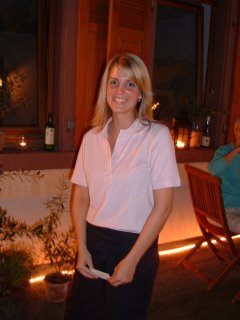
Julia Engelke, Weinkönig restaurant, Dossenheim
Heidelberg is every bit as enchanting as its reputation promises. We spent an entire day exploring the ruined castle, the town itself, and the Philosophenweg, the path across the Neckar River where the university’s scholars are supposed to think deep thoughts as they gaze across at the castle. Important parts of the castle had been built by Elector Frederick V, who was married to Elizabeth Stuart, the daughter of England’s James I. We had encountered this couple in Prague, where he reigned all too briefly as the “Winter King” at the start of the Thirty Years’ War, and earlier at Het Loo Palace in the Netherlands, where they lived in exile with William and Mary. Vindication came only posthumously, when their grandson became George I of England.
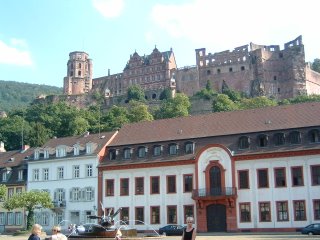
Heidelberg Castle

Heidelberg Castle
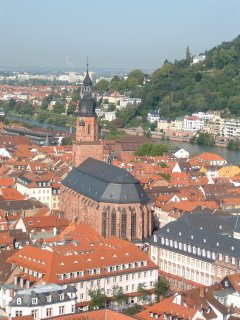
Heilig-Geist-Kirche as seen from Castle
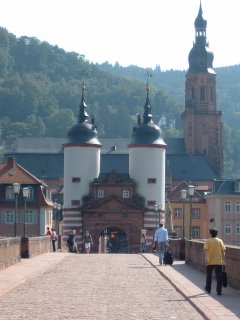
Heidelberg gate on Alte Brücke
Tuesday was “roots day,” for we made expeditions to the cities where some of our forbearers lived before heading across the Atlantic. Todd is descended from the Brotzmann family, who emigrated from Pirmasens near the French border, and Georgia is a member of the Gramlich family, late of Darmstadt. Both cities were disappointing in one sense, for nothing in Pirmasens antedated the Brotzmanns’ departure in the early 18th Century and Darmstadt’s fascinating Jugendstil buildings, the city’s major draw, were built well after the Gramlichs had decamped in 1849. However, we stopped en route to visit the huge Romanesque cathedral in Speyer, second only to Cluny in size and the site of several imperial tombs. The parliament of the Holy Roman Empire held 50 sessions here, most famously in 1529, when the Lutheran princes protested against the decision of the Catholic majority, giving rise to the appellation “Protestant.”

Pirmasens city hall
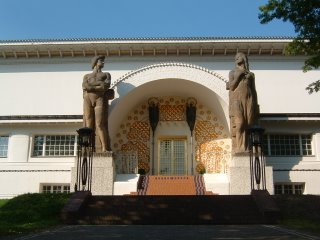
Ernst-Ludwig Haus, Mathildenhöhe, Darmstadt
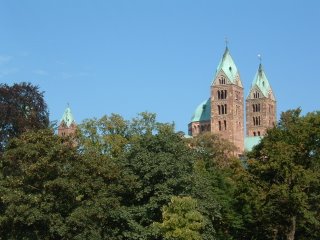
Cathedral of St. Mary and St. Stephen, Speyer
The following day we headed for Strasbourg by way of Karlsruhe and Baden-Baden. Dating only from the 18th Century, Karlsruhe is a very attractive small city, laid out in a fan shape around the palace and its large surrounding garden, which easily accommodates the German Constitutional Court. Not surprisingly, Baden-Baden reminded us of Karlovy Vary as the best people frequented both in the 19th Century. We sampled the local water at the Trinkhalle, using our special Karlovy Vary mug, and found it up to standard. As far as we could see, the main difference between the two spas is the existence of a casino at Baden-Baden--although we didn’t try out luck.
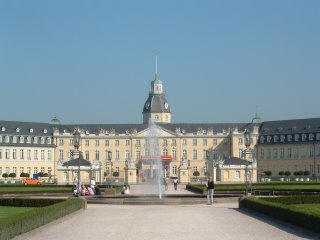
Karlsruhe Schloss

Trinkhalle, Baden-Baden
Strasbourg is a wonderful contradiction—an old German city, traditionally Protestant (Albert Schweitzer was pastor of a local church), with a heavy French overlay since its annexation by France in the late 17th Century. It is also an exceptionally beautiful city, thanks in part to its location on the River Ill and its canals and in part to some superb architects, both German and French. The cathedral is as beautiful as any we have seen on this trip with extraordinary carvings and a tower that can be seen from miles around. However, many old commercial and residential buildings are also models of their genre, such as the Kammerzell House on Cathedral Square.
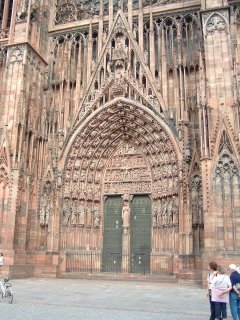
Main portal of Notre Dame Cathedral
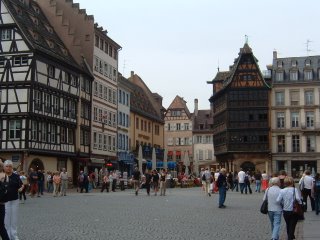
Cathedral Square with Kammerzell house

Tanners' houses
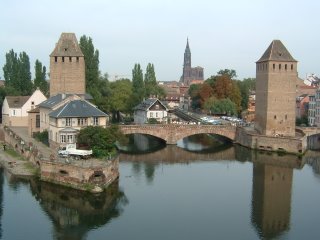
Ponts Couverts with cathedral in distance
Since Alsatian cuisine is legendary, Georgia treated Todd to a belated birthday dinner at Crocodile, one of Strasbourg’s best restaurants. Both of us decided on pigeon for a main course but split our entrees between sardines (Todd) and foie gras (Georgia) and our desserts between pannacotta (Todd) and a blueberry soufflé tart (Georgia). The cheese selection beggars description, and the Alsatian wines complemented everything beautifully. Mighty good eating!
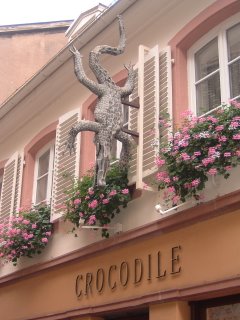
Crocodile restaurant (The actual crocodile inside the restaurant was brought from Egypt following Napoleon's campaign!)

0 Comments:
Post a Comment
<< Home